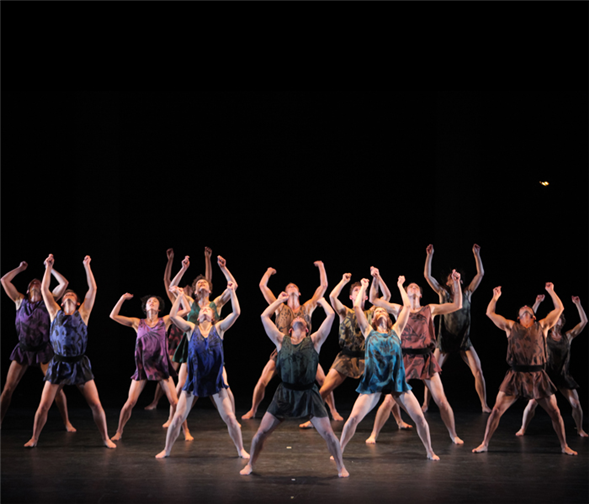Inside the company's return to New York
---
The
Mark Morris Dance Group tours globally – they're even making two separate trips to Australia this year – but it's been quite a while since they've brought repertory programs to their longtime New York performance venue, the Brooklyn Academy of Music.
Fortunately for dance fans, MMDG is returning to the BAM Opera House in a major way next week.
From April 22-26, they're presenting two separate programs of seven (mostly recent) Morris dances, all performed to live music. New York audiences will finally get to see
Spring, Spring, Spring, the 2013 work Morris created to Stravinsky's
The Rite of Spring – not the full orchestral score, but the version by the innovative jazz trio
The Bad Plus. There will also be a world premiere,
Whelm, set to three Debussy piano pieces, and the company's first New York presentation of
Pacific, a sensuously beautiful work Morris made in 1995 for San Francisco Ballet.
Two of Morris' most distinctive veteran dancers took time recently to discuss both the repertory and the particular thrills and challenges of dancing for the renowned choreographer. Between them, Lauren Grant and Michelle Yard have logged 35 years of experience with his endlessly diverse, musically sophisticated work.
Grant, who has danced Morris's choreography since 1996, says performing
Spring, Spring, Spring is particularly demanding. "We're on high alert," she explains. "We are all helping each other out tremendously. We have to be cueing each other and counting and
so present. The whole score is so rhythmic, in the craziest way. There is no relaxing in that dance."
She emphasizes that Morris steered clear of the score's typical associations with sacrificial maidens and pagan Russian ceremonies. "I remember Mark telling us that Stravinsky didn't want a plot in this. So he's honored that."
{Image1}
The oldest work on the BAM programs is
Grand Duo, one of Morris' most majestic, enduring creations. Choreographed in 1993 and set to Lou Harrison's Grand Duo for Violin and Piano, it's never out of the repertory for long. Like the Stravinsky, it is a large ensemble work, requiring 14 dancers. Its four sections range from hypnotic mysteriousness to cathartic frenzy.
"That dance is very layered," says Yard, a Brooklyn native who joined MMDG in 1997. "When you get in the company, it's pretty much in the repertory, so you have an opportunity to learn it right away. You get to learn many different parts, which is great. You see what everybody is doing, instead of just going in and learning a specific part. The rhythms are so specific. Once that stuff is in your body, that never goes away."
Grant notes that the opening movement of
Grand Duo incorporates "highly structured improvisation. We do a basic phrase, but we vary the timing. Mark hates when things get to be just the same, by rote. So he always wants us to be fresh. He makes something that will surprise him, from show to show."
Both women say performing with the troupe requires constant, rigorous attention. "All of Mark's dances have their own lives," says Yard. "He doesn't ever want everything to look the same. Every movement has a detailed quality that makes it different from something else, and that's what makes his work so full. I think what's kept me going is that he's constantly challenging himself. He never sticks to the same thing."
Grant, meanwhile, credits Morris for teasing out new elements of her artistry. Being especially petite, she'd encountered situations where her height determined her employment (or lack thereof) and how she was perceived. "I loved how Mark just looked at your dancing," she says. "He challenged me. Just because I'm short doesn't mean I have to act 'short' or dance 'short.'"
She continues, "That's the other thing I love about him. He wants everybody to explore contrasting sides of themselves as a dancer. If you're a staccato dancer, work on your legato. If you're cute, then dance tough. He teaches company class every day when he's there, and that's where so much of the work gets done. That's where he grooms us and molds us in every way – technically, musically – and shapes our work ethic.
"And he does the same for your personality. He wants you to keep questioning things in the world, questioning yourself – being curious, intelligent. It's tough love. He is extremely difficult to work for, but so entirely rewarding. It's a very intense experience. But I'm forever changed as a dancer, an artist, a person, and a teacher."
---
Susan Reiter frequently writes about dance for TDF Stages
Top photo (from "Grand Duo") by Erin Baiano. "Spring, Spring, Spring" photo by Peg Skorpinski.
